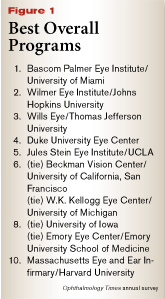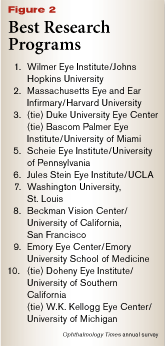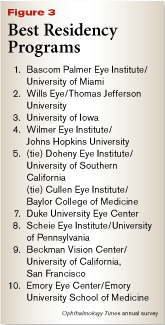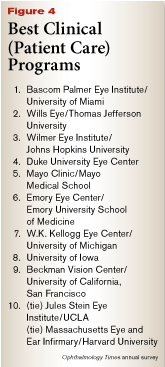Article
Bascom Palmer gains top spot in annual survey
The Bascom Palmer Eye Institue, University of Miami School of Medicine, sweeps three categories-Best Overall, Best Residency, and Best Clinical (Patient Care) Programs-in the 13th annual Ophthalmology Times' Best Programs survey. The Wilmer Eye Institute, Johns Hopkins University School of Medicine, Baltimore, takes the top honors for Best Research Program. Chairpersons and residency directors from U.S. departments of ophthalmology ranked programs nationwide.
The economic downturn might have the nation feeling a little unsettled these days, but one thing that remains in focus is the commitment by America’s ophthalmology programs to provide quality patient care, train excellent physicians, and dig deep for treatments for vision problems.
Nowhere is that commitment to excellence more pronounced than at the Bascom Palmer Eye Institute, University of Miami Miller School of Medicine, which-for the first time-has earned recognition as the best overall ophthalmology program in the country in the 2008 Ophthalmology Times Best Programs survey.
The Bascom Palmer Eye Institute has unseated the Wilmer Eye Institute at the Johns Hopkins University School of Medicine, Baltimore, which had held that top ranking for all 12 prior years the annual survey was conducted.
The Miami-based school also ranked number one for its residency and clinical (patient care) programs. It tied with Duke Eye Center at Duke University for third place for its research program.
"It’s a very nice accolade," said Eduardo C. Alfonso, MD, professor and interim chairman, Bascom Palmer Eye Institute. "This place continues to be a fantastic place. I’ve been working here since I was a resident in 1980, and it’s a fun place [to work]."
This year, the Wilmer Eye Institute ranked second for Best Overall program (See Figure 1), and Wills Eye at Thomas Jefferson University, Philadelphia, placed third, as it had last year-it was fourth in 2006, behind Jules Stein Eye Institute, University of California, Los Angeles.

Survey results were tabulated from a poll of U.S. ophthalmology department chairpersons and residency directors. Results were tabulated from a 15% response rate. The awards recognize excellence in the teaching and development of residents, quality patient care, and aggressive research pursuits.
‘We’re blessed’
The Bascom Palmer Eye Institute-with its locale in a large metropolitan area so close to this country’s southern border-has become as well known in Central and South America and the Caribbean as it has throughout the United States. Physicians throughout the region refer patients to Bascom Palmer Eye Institute for treatment of especially difficult or unique cases, Dr. Alfonso said.
He pointed to the increasing amount of research that the Bascom Palmer Eye Institute is conducting, thanks to increasing levels of funding from private and public sources. Clinicians and basic scientists attend each other’s weekly conferences to enhance opportunities for collaboration and bring technical questions to the researcher for answers that can be applied immediately in the clinical setting, he said.
The Bascom Palmer Eye Institute is in the process of a major expansion, Dr. Alfonso said, and will include space for ophthalmologists to work alongside other specialists. The institute also is working to formalize a way for researchers to collaborate with others in another country.
"What we want to do is not just develop translational research here in this physical environment, but carry it to other centers around the world," Dr. Alfonso said.
He said he is following a strategic plan put in place by his predecessor, Carmen Puliafito, MD, who left in August 2007 to become dean at the University of Southern California’s (USC) Keck School of Medicine. During Dr. Puliafito’s tenure, the Bascom Palmer Eye Institute moved from 34th to 14th place in 3 years in the amount of National Institutes of Health (NIH) funding for research, and the faculty size doubled. In addition, he said, Bascom Palmer has a friend in the university’s president, Donna Shalala, the former U.S. secretary for health and human services, who is working to promote the university on the international scene.
"You continue to see progress, expansion, new programs, and the possibility of even continuing to expand more," Dr. Alfonso said. "We’re blessed. Everything that happens here continues to move the place forward."
‘Desire to improve constantly’
After 12 years at the top of the survey, the Wilmer Eye Institute is pleased to share the limelight as it continues to grow and excel, according to Peter J. McDonnell, MD, director and William Holland Wilmer Professor of Ophthalmology at the institute. He also is chief medical editor of Ophthalmology Times.
"I am sure the people at Wilmer Eye Institute wish to congratulate other departments that have moved up in the rankings this year," he said. "Our desire is to improve constantly upon how we do things, so that we excel in all areas of our mission [teaching, research, and patient care]."
That growth comes at a price, as 130 full-time faculty and expanding collaborative research require more space in which to work-something not easy in its land-locked part of Baltimore. A new, fourth, $108 million building under construction is scheduled for completion next summer, offering 210,000 square feet of breathing room, however.
"There is no doubt in my mind that this will build upon and strengthen what we do in patient care, research, and teaching and will allow us to add new faculty with exciting new skills to what already exists at Wilmer," Dr. McDonnell said.
While the Bascom Palmer Eye Institute and Wilmer Eye Institute simply traded spots in the Best Overall category, the program at Wills Eye at Thomas Jefferson University, Philadelphia, remains solidly at number three again this year. Wills Eye also improved its rank from third to second in both the residency and clinical (patient care) programs, and it garners an "honorable mention" for just missing a spot in the research category (See Figure 2).

All of that pleases Julia A. Haller, MD, who took the helm as ophthalmologist-in-chief and chairwoman of the department earlier this year.
"It is very energizing to hear that the excellence we strive so hard for every day is recognized by our peers," she said. "The motto on our seal says ‘Skill with Compassion.’ That is very much what our physicians and staff bring to the clinical care of each and every patient treated here and what we work toward instilling in our residents, medical students, and fellows."
As the nation’s first eye institute and home of its oldest residency program, Wills Eye boasts a long tradition of excellence, beginning with its staff, she said. In addition, the school is "exploding" with new initiatives, including a new clinical research program, a new director of the pediatrics service, and a new Department of Defense grant that will build an updated diagnostic center, plus new international initiatives and Web-based learning programs.
Although the Bascom Palmer Eye Institute, Wilmer Eye Institute, and Wills Eye perennially have placed in the top three, the ophthalmic program at Emory Eye Center, Atlanta, emerged as a new name on the Best Overall Program list. The center tied with the University of Iowa for number eight, and also appears at number nine for Best Research program, number 10 for Best Residency program (See Figure 3), and number six for Best Clinical (Patient Care) program (See Figure 4). The center’s Department of Ophthalmology includes 23 ophthalmologists, nine basic scientists, and 11 post-doctoral fellows-as well as nine researchers in other Emory departments who hold joint appointments in ophthalmology.

Doheny Eye Institute at the University of Southern California, Los Angeles, Casey Eye Institute in Portland, and the Scheie Eye Institute at the University of Pennsylvania, Philadelphia, also deserve "honorable mentions" for rankings that fall just below the top 10 for Best Overall program.
At the Doheny Eye Institute, Ronald E. Smith, MD, credited several changes to its residency program that have made for more successful residents who are able to pursue research opportunities at the same time. For example, the school now assigns a faculty mentor to each first-year resident a few months before his or her residency begins. In addition to its high ranking overall, the Doheny Eye Institute moved from number nine to number five for Best Residency program.
"We think this [program] provides a jump-start for each resident," Dr. Smith said. It also has improved microsurgical wet-lab training.
"These changes have resulted in residents who more successfully balance the rigorous educational program and the intensive clinical experience here with the numerous opportunities for vision research available to them at Doheny and USC," he said.
For the second year, the program at Casey fell just below the top 10 for Best Overall Program. David J. Wilson, MD, holder of the Thiele-Petti Chair, Department of Ophthalmology, and director of the institute’s eye pathology laboratory, said the program’s faculty is beginning to pre-sent more research at conferences, gaining greater respect from other department chairs. He said the substantial financial support from Oregon’s Elks Club helps create "a very consistent and high-performing academic department." The program also receives an honorable mention for its clinical (patient care) program.

"The research programs here have really grown a lot in prominence, especially in the area of retinal research and inflammatory eye disease research," Dr. Wilson said. "We’re well within the top 10 in NIH research rankings. That probably contributes to the overall reputation of the department."
He said he is excited about the work his department is doing regarding gene- and cell-based therapy for inherited retinal diseases and conditions, including Leber’s congenital amaurosis (LCA), achromatopsia, and x-linked retinoschisis.
"That’s going to be a new area . . . in terms of how we use these new methods in treating eye disease," Dr. Wilson said.
Gene therapy work also is being pursued intensively at the Scheie Eye Institute, University of Pennsylvania School of Medicine, which moved from number four last year to number five on the list for Best Research Program but appears just off the top 10 for Best Overall Program. It also ranked number eight for Best Residency Program.
Stuart L. Fine, MD, the William F. Norris and George E. DeSchweinitz Professor of Ophthalmology and director of the institute, said preliminary results from two gene therapy trials for patients with LCA were reported recently in the New England Journal of Medicine and the Proceedings of the National Academy of Sciences.
The Scheie Eye Institute also was selected by the NIH to run the multicenter clinical trial comparing ranibizumab (Lucentis, Genentech) with bevacizumab (Avastin, Genentech) in the treatment of neovascular age-related macular degeneration (AMD). "This trial is arguably the most significant trial currently supported by the National Eye Institute (NEI)," Dr. Fine said. "It could save Medicare $4 billion to $6 billion every year [if bevacizumab is proved as effective as ranibizumab in treating AMD]."
Research excellence
When it comes to ophthalmic research, Massachusetts Eye and Ear Infirmary (MEEI), Harvard University, Boston, is difficult to beat. The school has placed second on the list for at least the past 4 years, just behind the Wilmer Eye Institute.
Under the direction of Joan W. Miller, MD, the research program at MEEI has retained a strong presence in basic and translational research. Her work is boosted by the addition this year of five vice chairmen to provide additional leadership in each area of the department. For example, Michael S. Gilmore, PhD, president and chief executive officer, Ankeny Director of Research, senior scientist, Schepens Eye Research Institute, and the C.L. Schepens Professor of Ophthalmology, Harvard Medical School, is now vice chairman for basic research and is helping to develop cross-department research opportunities.
The program was ranked 10th for best overall and tied for 10th for best clinical care, but, to Dr. Miller’s surprise, didn’t rank among the top for its residency program. She pointed to a virtual surgical program developed by John I. Loewenstein, MD, and Bonnie An Henderson, MD, that allows students to sit at a computer and work through steps of various surgeries with "pop-up surgeons" who can help when they get into trouble. Weekly residency steering meetings between Dr. Miller and other program directors address issues that arise.
"We really strive to provide a supportive environment for the residents in which we have high expectations of their learning, and the residents recognize and appreciate that," she said. Deserving "honorable mention" in the research category are the programs at University of Iowa, Wills Eye, and the University of Wisconsin, Madison.
At the Department of Ophthalmology and Visual Sciences at the University of Iowa, Keith D. Carter, MD, professor and department head, and holder of the Lillian C. O’Brien and Dr. C.S. O’Brien Chair in Ophthalmology, said a diverse faculty and "first-rate research team" help to promote important basic and clinical research.
"Some of our faculty are internationally known and have been with us for many years," he said. "We also have several bright young faculty who bring new interests and enthusiasm to the practice and teaching of ophthalmology."
The program also earned a number three spot for Best Residency (up a notch from last year) and a number eight rank for Best Clinical (Patient Care) program.
Although the program at the University of Wisconsin School of Medicine and Public Health did not make last year’s ranking for its research program, it was number nine in 2006 and again merits "honorable mention" this year for that category.
"We have great faculty, staff, fellows, and students, and research has always been a core mission for us-not just lip service or window-dressing," said Paul L. Kaufman, MD, the Peter A. Duehr Professor and chairman, Department of Ophthalmology & Visual Sciences.
In terms of NEI funding, the school has been among the top five for many years, he said.
Funding future growth
Although all of these ophthalmology programs have been strong for years, they rely heavily on public and private grants and donations to maintain that strength. In an era when endowment funds are suffering setbacks, the chairpersons of these departments said they are concerned, yet confident that private philanthropists will help them weather the storm.
"The economic downturn concerns us all, of course, but in this context more in terms of how it affects federal budgetary allocations to NIH rather than Wall Street valuations per se," Dr. Kaufman said. "The latter correct themselves over the long term, and we don’t live off the valuations year to year. To the extent that they influence donations we pay attention, but this also evens out over time. "The key is diversification," Dr. Kaufman said. "NIH, private foundations, philanthropy, investments, corporate projects, and unrestricted giving are all important. In principle, this is not different from any prudent financial planning."




